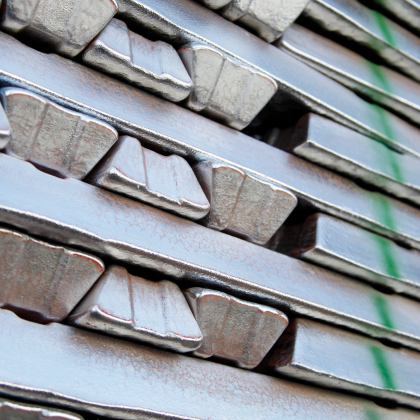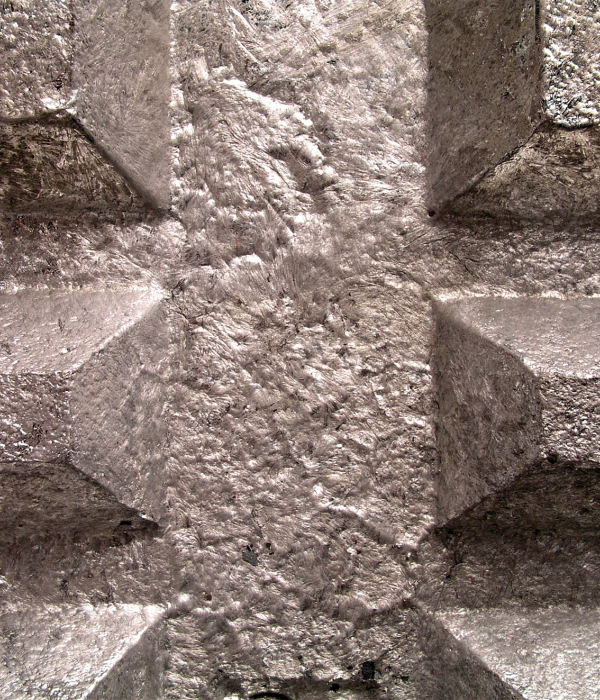AI • Atomic Number 13

Aluminum
Aluminum is a silvery-white lightweight metal. It stands out due to its low weight, corrosion resistance, and good thermal conductivity. It is easily formable and non-magnetic. Aluminum has roughly one-third the density of iron. Its melting point is relatively low at 660 degrees Celsius.
It is the third most abundant element and the most common metal in the Earth's crust.
After iron, aluminum is the second most important metal for industry. Its primary uses are in the construction sector and lightweight engineering (automotive industry, aerospace).
The Weipa mine in Australia is the largest bauxite deposit in the world — bauxite being the mineral from which aluminum is extracted. Bauxite gets its name from its first discovery site, Les Baux-de-Provence in southern France, where it was discovered in 1822 by geologist Pierre Berthier.
The largest bauxite producer is Rio Tinto, followed by Winning International, which operates the Simandou mine in Guinea. Guinea holds the largest aluminum reserves worldwide.
China is the global market leader in aluminum production, holding a market share of nearly 60 percent. The leading companies are Chinalco and Hongqiao Group.
Aluminum can be recycled without any loss of quality, and the recycling process requires only a fraction of the energy needed for primary production.

Alum (an aluminum salt) was already known in antiquity. In ancient Egypt and Rome, it was used in medicine and for dyeing purposes.
In 1754, German chemist Andreas Sigismund Marggraf identified alumina (Al₂O₃) as a distinct substance. Later, the French chemist Antoine Laurent de Lavoisier was the first to suggest that the alumina Marggraf had derived from an alum solution was likely the oxide of an as-yet-unknown element.
In 1808, British chemist Sir Humphry Davy made the first attempt to produce aluminum via electrolysis, but was unsuccessful. However, he introduced several name variants for the element – alumium, aluminum, and aluminium – two of which, aluminum and aluminium, continue to coexist in English today.
Aluminum was finally successfully isolated in 1825 by Danish physicist Hans Christian Ørsted. Several chemists then worked to improve the production process, including Friedrich Wöhler, who in 1845 succeeded in producing tiny aluminum globules, allowing him to determine the metal’s density.
In 1846, Henri Étienne Sainte-Claire Deville continued efforts to improve and, crucially, lower the cost of aluminum production. He persuaded Emperor Napoleon III to financially support the development of industrial aluminum production. Deville began production in the chemical factory of the Rousseau brothers, refining the Wöhler process by replacing expensive potassium with cheaper sodium as a reducing agent. This significantly reduced aluminum production costs: in 1854, 1 kg of aluminum still cost 3,000 francs, but by 1860, the price had dropped to 130 francs per kg.
In 1886, Charles Martin Hall and Paul Héroult independently developed the Hall-Héroult process, the electrolysis method that remains the standard for aluminum production today.
In 1889, Carl Josef Bayer invented the Bayer process to extract pure alumina from bauxite, laying the foundation for modern large-scale aluminum production.
By the late 19th century, aluminum began to be used on an industrial scale. Production facilities were built next to hydroelectric power stations—such as those at Niagara Falls (USA) and along the Upper Rhine (Switzerland)—to take advantage of low-cost electricity. As a result, aluminum could be produced cheaply and became affordable for everyday consumer goods. The military was one of the first to adopt aluminum for practical use, seeking weight reduction in soldiers’ equipment. Aluminum was used to produce canteens, cooking utensils, and tent poles.
Because of its low weight, aluminum was ideal for aviation. Its role in aerospace began with the Zeppelin, which took its first successful flight in 1900, launching aluminum’s career in the skies.
The construction industry is the largest consumer of aluminium, accounting for between one quarter and one third of total global production.
The packaging industry, automotive sector, and aerospace each consume around one fifth of the global output.
Other important applications include electrical engineering and mechanical engineering. Electric vehicles require around 30% more aluminium than combustion-engine vehicles.
China is the world’s largest consumer of aluminium, driven by government infrastructure projects both domestically and abroad.
Bauxite is the primary mineral used in aluminium production. It contains 50 to 60 Ppercent aluminium oxide and around 30 percent iron oxide.
Aluminium is extracted from bauxite in a two-step process: The Bayer process is first used to produce aluminium oxide (also called alumina). In a second step, the Hall-Héroult process reduces the alumina to aluminium metal. A by-product of this process is iron-rich red mud.
Guinea is the world's largest producer of bauxite and also holds the largest known reserves. Australia ranks second in extraction and has the second-largest alumina production globally. China is the third-largest bauxite mining country.
The Weipa mine in Australia, owned by the Rio Tinto Group, is the largest bauxite mining site in the world. Rio Tinto is the global market leader in bauxite production, followed by the Winning International Group and the government of Guinea.
Bei der energieintensiven Aluminiumherstellung ist China mit einem Marktanteil von fast 60 Prozent global führend. Russland, Kanada und die Vereinigten Arabischen Emirate sind weitere wichtige Aluminiumhersteller.
Due to the high energy requirements of aluminium production, China dominates the global market with a share of nearly 60 percent. Other major producers include Russia, Canada, and the United Arab Emirates.Global annual bauxite production exceeds 400 million tonnes, yielding around 140,000 tonnes of primary aluminium per year.
Because of the significantly lower energy demand, aluminium recycling plays an important role. Aluminium is one of the most recycled metals worldwide. North America has the highest aluminium recycling rate globally, at nearly 60 percent.
Composite materials can replace aluminum in aircraft fuselages and wings.
Glass, paper, plastics, and steel can substitute aluminum in packaging. Composites, magnesium, steel, and titanium can replace aluminum in ground transportation.
Composites, steel, vinyl, and wood can substitute aluminum in construction.
Copper can replace aluminum in electrical and heat exchange applications.

